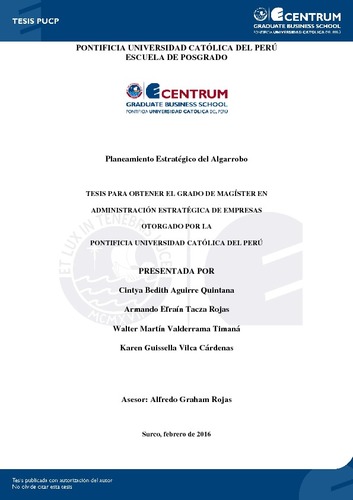| dc.contributor.advisor | Graham Rojas, Alfredo | |
| dc.contributor.author | Aguirre Quintana, Cintya Bedith | es_ES |
| dc.contributor.author | Tacza Rojas, Armando Efraín | es_ES |
| dc.contributor.author | Valderrama Timaná, Walter Martín | es_ES |
| dc.contributor.author | Vilca Cárdenas, Karen Guissella | es_ES |
| dc.date.accessioned | 2016-11-07T16:45:57Z | |
| dc.date.available | 2016-11-07T16:45:57Z | |
| dc.date.created | 2016 | |
| dc.date.issued | 2016-11-07 | |
| dc.identifier.uri | http://hdl.handle.net/20.500.12404/7426 | |
| dc.description.abstract | Este documento constituye un plan estratégico para el algarrobo en el Perú, que cubre a las regiones de Lambayeque, Piura y Tumbes, dentro de los cuales se encuentra el bosque seco tropical. Dicha zona cuenta con las condiciones climáticas ideales para el cultivo de este árbol, sin embargo, esta actividad recién se está organizando en los últimos años gracias a la conformación de cooperativas o asociaciones. Las cuales no solo se encargan de producir, compaginando esta actividad con otras tareas productivas, sino que también aprendieron a procesar el fruto del algarrobo. Uno de los principales hallazgos de este trabajo es que la cadena de valor del algarrobo no se encuentra completamente integrada, ya que se ha descuidado el área de comercialización. Es por este motivo que los derivados del fruto, que son la harina o el mucílago, no llegan a los consumidores, que pueden ser industrias o clientes finales. En el caso de las industrias se han encontrado usos para preparar galletas, helados y en general sirven de endulzante, entre muchas otras aplicaciones que tiene, como leña o antisépticos. Se crea este planeamiento para que, en el año 2026, el algarrobo contribuya a alcanzar un mayor desarrollo rural, sustentado en el procesamiento y comercialización de sus derivados. Para lograrlo se implementarán estrategias que permitan mejorar las competencias de exportación, así como la generación de alianzas estratégicas que potencien las políticas de investigación y desarrollo, y ampliar la penetración en el mercado de Estados Unidos. Para garantizar que la implementación de estas y otras estrategias sea apropiada se harán revisiones anuales de los resultados, además de tener hitos de cumplimiento en determinados años que se expresan en los objetivos de corto plazo. Dicha revisión se desarrollará utilizando como herramienta el tablero de control balanceado, específicamente desarrollado para el algarrobo | es_ES |
| dc.description.abstract | This document is a strategic plan for the carob in Peru, which covers the regions of Lambayeque, Piura and Tumbes, within which the dry tropical forest is. This area has ideal climatic conditions for growing this tree, however, this activity is just being organized in recent years thanks to the formation of cooperatives or associations. Which not only are responsible for producing, combining this activity with other productive tasks, but also learned to process the fruit of the carob.
One of the main findings of this work is that the value chain carob not fully integrated because it has been neglected marketing area. It is for this reason that fruit derivatives, which are flour or mucilage, do not reach consumers who may be industries or end customers. In the case of industries, we have found uses for crackers, ice cream and generally serve as a sweetener, among many other applications having as firewood or antiseptics. This planning is created so that, in 2026, carob contributes to a greater rural development, based on the processing and marketing of petroleum products. To achieve strategies to improve the skills of export will be implemented, as well as the generation of strategic alliances that strengthen policy research and development, and expand market penetration in the United States. To ensure that the implementation of these and other strategies are appropriate annual reviews of results, in addition to compliance milestones in certain years that are expressed in the short-term objectives will be made. Such review will be developed using as a tool the balanced scorecard, specifically developed for the carob. | es_ES |
| dc.language.iso | spa | es_ES |
| dc.publisher | Pontificia Universidad Católica del Perú | es_ES |
| dc.rights | info:eu-repo/semantics/openAccess | es_ES |
| dc.rights.uri | http://creativecommons.org/licenses/by-nc-nd/2.5/pe/ | * |
| dc.subject | Algarrobo--Cultivo--Perú | es_ES |
| dc.subject | Planificación estratégica | es_ES |
| dc.title | Planeamiento estratégico del algarrobo | es_ES |
| dc.type | info:eu-repo/semantics/masterThesis | es_ES |
| thesis.degree.name | Magíster en Administración Estratégica de Empresas | es_ES |
| thesis.degree.level | Maestría | es_ES |
| thesis.degree.grantor | Pontificia Universidad Católica del Perú. CENTRUM | es_ES |
| thesis.degree.discipline | Administración Estratégica de Empresas | es_ES |
| renati.discipline | 413307 | es_ES |
| renati.level | https://purl.org/pe-repo/renati/level#maestro | es_ES |
| renati.type | https://purl.org/pe-repo/renati/type#tesis | es_ES |
| dc.publisher.country | PE | es_ES |
| dc.subject.ocde | https://purl.org/pe-repo/ocde/ford#5.02.04 | es_ES |






